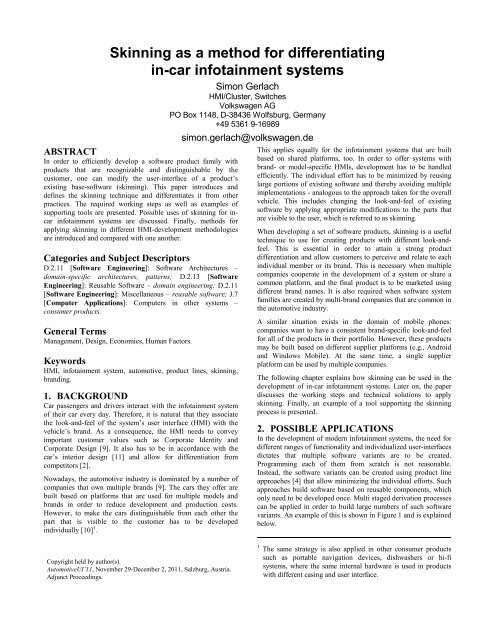Automotive User Interfaces and Interactive Vehicular Applications
Automotive User Interfaces and Interactive Vehicular Applications
Automotive User Interfaces and Interactive Vehicular Applications
Create successful ePaper yourself
Turn your PDF publications into a flip-book with our unique Google optimized e-Paper software.
Skinning as a method for differentiating<br />
in-car infotainment systems<br />
Simon Gerlach<br />
HMI/Cluster, Switches<br />
Volkswagen AG<br />
PO Box 1148, D-38436 Wolfsburg, Germany<br />
+49 5361 9-16989<br />
ABSTRACT<br />
In order to efficiently develop a software product family with<br />
products that are recognizable <strong>and</strong> distinguishable by the<br />
customer, one can modify the user-interface of a product’s<br />
existing base-software (skinning). This paper introduces <strong>and</strong><br />
defines the skinning technique <strong>and</strong> differentiates it from other<br />
practices. The required working steps as well as examples of<br />
supporting tools are presented. Possible uses of skinning for incar<br />
infotainment systems are discussed. Finally, methods for<br />
applying skinning in different HMI-development methodologies<br />
are introduced <strong>and</strong> compared with one another.<br />
Categories <strong>and</strong> Subject Descriptors<br />
D.2.11 [Software Engineering]: Software Architectures –<br />
domain-specific architectures, patterns; D.2.13 [Software<br />
Engineering]: Reusable Software – domain engineering; D.2.11<br />
[Software Engineering]: Miscellaneous – reusable software; J.7<br />
[Computer <strong>Applications</strong>]: Computers in other systems –<br />
consumer products.<br />
General Terms<br />
Management, Design, Economics, Human Factors.<br />
Keywords<br />
HMI, infotainment system, automotive, product lines, skinning,<br />
br<strong>and</strong>ing.<br />
1. BACKGROUND<br />
Car passengers <strong>and</strong> drivers interact with the infotainment system<br />
of their car every day. Therefore, it is natural that they associate<br />
the look-<strong>and</strong>-feel of the system’s user interface (HMI) with the<br />
vehicle’s br<strong>and</strong>. As a consequence, the HMI needs to convey<br />
important customer values such as Corporate Identity <strong>and</strong><br />
Corporate Design [9]. It also has to be in accordance with the<br />
car’s interior design [11] <strong>and</strong> allow for differentiation from<br />
competitors [2].<br />
Nowadays, the automotive industry is dominated by a number of<br />
companies that own multiple br<strong>and</strong>s [9]. The cars they offer are<br />
built based on platforms that are used for multiple models <strong>and</strong><br />
br<strong>and</strong>s in order to reduce development <strong>and</strong> production costs.<br />
However, to make the cars distinguishable from each other the<br />
part that is visible to the customer has to be developed<br />
individually [10] 1 .<br />
Copyright held by author(s).<br />
<strong>Automotive</strong>UI’11, November 29-December 2, 2011, Salzburg, Austria.<br />
Adjunct Proceedings.<br />
simon.gerlach@volkswagen.de<br />
This applies equally for the infotainment systems that are built<br />
based on shared platforms, too. In order to offer systems with<br />
br<strong>and</strong>- or model-specific HMIs, development has to be h<strong>and</strong>led<br />
efficiently. The individual effort has to be minimized by reusing<br />
large portions of existing software <strong>and</strong> thereby avoiding multiple<br />
implementations - analogous to the approach taken for the overall<br />
vehicle. This includes changing the look-<strong>and</strong>-feel of existing<br />
software by applying appropriate modifications to the parts that<br />
are visible to the user, which is referred to as skinning.<br />
When developing a set of software products, skinning is a useful<br />
technique to use for creating products with different look-<strong>and</strong>feel.<br />
This is essential in order to attain a strong product<br />
differentiation <strong>and</strong> allow customers to perceive <strong>and</strong> relate to each<br />
individual member or its br<strong>and</strong>. This is necessary when multiple<br />
companies cooperate in the development of a system or share a<br />
common platform, <strong>and</strong> the final product is to be marketed using<br />
different br<strong>and</strong> names. It is also required when software system<br />
families are created by multi-br<strong>and</strong> companies that are common in<br />
the automotive industry.<br />
A similar situation exists in the domain of mobile phones:<br />
companies want to have a consistent br<strong>and</strong>-specific look-<strong>and</strong>-feel<br />
for all of the products in their portfolio. However, these products<br />
may be built based on different supplier platforms (e.g., Android<br />
<strong>and</strong> Windows Mobile). At the same time, a single supplier<br />
platform can be used by multiple companies.<br />
The following chapter explains how skinning can be used in the<br />
development of in-car infotainment systems. Later on, the paper<br />
discusses the working steps <strong>and</strong> technical solutions to apply<br />
skinning. Finally, an example of a tool supporting the skinning<br />
process is presented.<br />
2. POSSIBLE APPLICATIONS<br />
In the development of modern infotainment systems, the need for<br />
different ranges of functionality <strong>and</strong> individualized user-interfaces<br />
dictates that multiple software variants are to be created.<br />
Programming each of them from scratch is not reasonable.<br />
Instead, the software variants can be created using product line<br />
approaches [4] that allow minimizing the individual efforts. Such<br />
approaches build software based on reusable components, which<br />
only need to be developed once. Multi staged derivation processes<br />
can be applied in order to build large numbers of such software<br />
variants. An example of this is shown in Figure 1 <strong>and</strong> is explained<br />
below.<br />
1 The same strategy is also applied in other consumer products<br />
such as portable navigation devices, dishwashers or hi-fi<br />
systems, where the same internal hardware is used in products<br />
with different casing <strong>and</strong> user interface.





